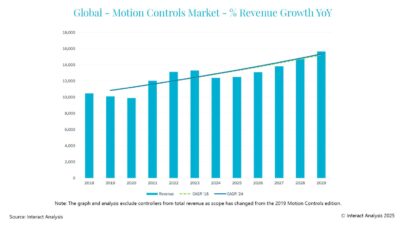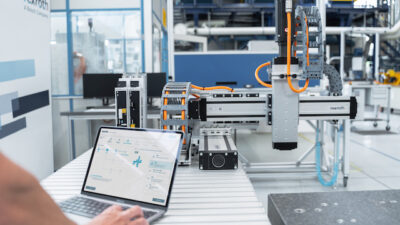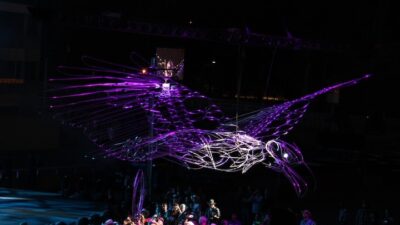Look for that big, honkin' steel structure back in the plant with chips flying and cutting fluid spraying and you'll find CNC (computer numeric control) at its nerve center. These specially designed controllers handle high-speed, high-precision, multi-axis coordinated motion control. CNC are at the core of large machining centers that manufacture complex metal parts for automotive, aerosp...
KEYWORDS
Machine control
Computer numeric control (CNC)
PC-based control
Networks & communication
Sidebars: What’s new in CNC technology? Control engineer’s toolkit
Look for that big, honkin’ steel structure back in the plant with chips flying and cutting fluid spraying and you’ll find CNC (computer numeric control) at its nerve center. These specially designed controllers handle high-speed, high-precision, multi-axis coordinated motion control. CNC are at the core of large machining centers that manufacture complex metal parts for automotive, aerospace, and many other products. On the other hand, CNCs are found controlling transfer lines for automobile engine manufacturing and similar processes.
Often responsibility for these controls was given to a specially trained engineer. Since CNCs incorporate PLCs as part of the logic control, they are now usually just another weapon in the control engineer’s arsenal, doing battle with the forces of manufacturing chaos.
Part programming is a standardized process including ‘M’ and ‘G’ codes, but the rest of the control has been a bastion of proprietary logic and configuration. Engineers are increasingly demanding an open platform for their control architecture. As Brian Honigford, controls engineer at Ford’s Lima (Ohio) Engine plant, says, ‘We want flexibility and the ability to add new components as they are developed. Our goal is to use best-in-class components.’
Does open go with CNC? Yes, it does. At September’s IMTS trade show in Chicago, CNC vendors were grouped in a large section of McCormick Place’s Lakeside Center building. It didn’t take a lot of walking through the exhibit to discover that almost everyone has an open solution. Many open solutions incorporate PC technology. This is understandable, since many of these companies also are machine control suppliers, who have been integrating open, PC technology with PLCs for some time.
There are many benefits of this strategy for engineers trying to make plants more productive and responsive to the current ‘e-manufacturing’ objectives.
An integrated manufacturing enterprise, such as depicted in this diagram,links control and information to make it more competitive.
Open CNC benefits users
Sal Spada, senior analyst, discrete manufacturing for ARC Advisory Group (Dedham, Mass.), says, ‘Open CNC solution allows CNC-based machine tool users to deploy a unified automation strategy, which depends on all the computer systems from engineering design centers to factory-floor machine tools to communicate seamlessly. Integrating distributed plant-wide information systems required to implement real-time process improvements facilitates continuous optimization of production systems. High- volume production plants as well as medium-scale job shops have another opportunity to make dramatic improvements in productivity, quality, and customer service by leveraging open software solutions.’ Increased user demands for service and support and willingness of system integrators and OEMs to respond has boosted success of ‘open’ CNC, adds Mr. Spada.
This need to communicate has been a continuing story in Control Engineering for some time. Constant technology improvements enable better and faster communications. Customers are requiring it. As Ford’s Mr. Honigford points out, ‘We have added ability to implement our plant operation monitoring as part of all our control specifications. We expect to be able to communicate information throughout the plant.’
Another consideration lies in the need for interface and view consistency across product lines. Reinhold Achatz, vp of Solutions and Software for Siemens Energy & Automation (Alpharetta, Ga.), notes he was head of development when the ‘Totally Integrated Automation (TIA)’ design principle was developed. ‘We thought it would be a big advantage if we designed into products: one engineering principle, one HMI philosophy, a common set of interfaces, and data integrity. This was defined five years ago.
‘CNCs are more or less a combination of motion control, PLC, CNC, and HMI,’ he adds. ‘So the PLC part of our new controls is the S7, which was designed within the TIA framework. We just added motion and CNC to the basic philosophy of TIA.’
Siemens introduced two PC-integrated, open CNCs at IMTS. Built on the PCU50 platform, its 840Di operates on Microsoft Windows NT and contains a motion-control interface board with Profibus-DP and OPC/COM communications. The Acromatic 2100Di is the first product developed since Siemens’ acquisition of Vickers. This small Microsoft Windows 2000 box is a CNC that maintains the traditional look. Microsoft Windows 2000 runs NT applications and offers additional capabilities.
Tools aid uptime
Rockwell Automation (Milwaukee, Wis.) has implemented a strategy across its product line known as ‘Complete Automation.’ This includes ‘Logix Anywhere’ and ‘View Anywhere.’ Its intent is to build in common logic and HMI architectures, configurations, and interfaces. This strategy extends to CNCs as well.
Fabio Malaspina, Allen-Bradley CNC product manager, Rockwell Automation, adds, ‘PCs and their intrinsic networking capabilities have revolutionized the way enterprises run office automation. Enterprises can now quickly adapt to market changes, better serve customers, and reduce operating costs. Information is available throughout the enterprise, locally and remotely, and-most of the time-it’s only a mouse click away.
‘Users today are strongly demanding that industrial automation providers make their products easier to integrate into the enterprise network.’ Mr. Malaspina suggests that Rockwell Automation has responded with industrial automation products that integrate PC technology and use open standard networks, such as Ethernet, ControlNet, and DeviceNet.
From a CNC perspective, the Allen-Bradley 9/PC is a PC-based CNC built on open standards, Rockwell Automation patents, and state-of-the-art PC technology. The 9/PC CNC design allows users to customize, collect, and monitor processes by using such open and standard PC technologies as Dynamic Data Exchange (DDE), OLE for Process Control (OPC), COM/DCOM, and Ethernet.
With the 9/PC CNC, users can now view production information from any networked PC by pointing a web browser to the machining application and pulling real-time production information off the shop floor. This facilitates vertical information flow for improved time and order tracking and helps ensure overall production efficiency.
Richard Rey, CNC Account Executive, Rexroth Indramat (Hoffman Estates, Ill.), notes, ‘System200 uses PC technology with networking and information sharing between motion controllers and logic controllers for all machining and material handling systems used on plant production floors. The system consists of a multiprocess, multiaxis CNC including PLC and HMI that is common across the platform. OEMs can use HMI programming tools to set up the machine and create HMI screens.’
Indramat’s PLC uses IEC 61131 compliant programming tools. With the editor, programmers can view ladder logic, declaration list, I/O list, etc. in multiple windows. Communications include SERCOS from CNC to drives, fieldbuses like Interbus and Profibus to I/O devices, and Ethernet for information sharing.
Open means productivity
‘Open systems means productivity,’ proclaims Jeff Kao, vp of CNC Business at GE Fanuc Automation (Charlottesville, Va.). ‘Why? Because machines are no longer islands. They can’t afford to be. Quality, accuracy, productivity, and even basic day-to-day operator safety demand that machines and equipment communicate-with operators, plant managers, corporate leaders, and even customers.’
GE Fanuc has backed this up with the release of its Open Factory CNC family. This product line combines PC hardware, Microsoft Windows-based applications, and traditional CNC hardware. The software suite includes VisualDocs to manage documents at the machine tool; VisualMEM to gather machine performance information; VisualDNC to download part programs from local area networks; and VisualMOI to integrate machine tool operation with production scheduling and electronic documentation. Plus the Open Factory Bolt-On product includes a DuraTouch industrial PC, enhanced version of Gibbs Shop Floor Programming, and CimWorks software tools to expand existing CNCs’ functionality.
Scott Rohlfs, CNC applications engineering manager for Mitsubishi Electric Automation (Vernon Hills, Ill.), notes, ‘Trends and technologies in several product areas are coming together to provide open solutions in CNC technology. These include a new, easier-to-use PLC editor plus HMI that is user customizable with Visual Basic and Visual C++. The C64 CNC enables lower cost control of manufacturing cells. It controls up to 14 axes is capable of controlling up to seven program paths simultaneously. The product offers connectivity to Mitsubishi’s networks, as well as Ethernet, Profibus, and DeviceNet. Other advances in spindle drive technology further aid manufacturing productivity.’
Schneider Electric’s Num Corp. (Naperville, Ill.) provides Axium CNC using a standard PC that allows use of Microsoft’s Visual Basic, Visual C++, Excel, and Word. The Intel Pentium-based controller runs under Windows 98 or NT, supporting real-time CNC functions plus user interface, internal database, servo drive coupler, and incorporated PLC. Users can apply standard development tools, object libraries, and open interfaces, like OPC to facilitate customization and connection.
Open platform pioneer
MDSI (Ann Arbor, Mich.) has been retrofitting machine tools with PC-based CNC for over two years. Jim Fall, president, explains, ‘We have been talking about how to put control on the Internet for over two years. PC connectivity and open APIs allow interface with tools like air gages, enabling a manufacturer to increase throughput. We have a customer who showed 100% productivity gain because of this connectivity.’
The company’s Open CNC allows a user to trigger data collection and distribution from a CNC using a standard part program. Data integration promotes integration between CAD/CAM and ERP/planning systems, enabling global B2B for manufacturing from within the machine tool. The control can send an e-mail to maintenance personnel or the production engineer when fault conditions are observed. Probing and inspection data can be collected and transmitted to SQL or Oracle database for ISO9000 tracking. The part program can be set to send process times and part completions directly to MES or ERP applications.
Beckhoff Automation (Verl, Germany; Minneapolis, Minn.) president, Gerd Hoppe, also touts the benefits of integrating different control along with HMI, communications, and information handling. Beckhoff’s TwinCat PC-based control software implements motion control as an IEC 61131 function block. Further, TwinCat allows G code and C coordinated motion programming. The implementation allows gearing, camming, progammable limit switch, and hydraulic control for such things as controlling pressure on a tool. The software controls up to 256 axes and three-axis interpolation times three implementations. It also implements OPC for information sharing with other applications.
In this era of rapidly converging technologies, machining transfer lines and machining centers need no longer be islands of automation. The entire plant is increasingly becoming an integrated organism. Actually, the organism expands far beyond the reaches of the physical plant including customers, suppliers, managers, and engineers located anywhere there is an Internet connection. The connection can be with either people or with their automated systems coordinating purchase orders, inventory, customer status inquiries, and sales.
For a manufacturing enterprise to be competitive today, and especially tomorrow, it is essential to develop an automation system capable of handling this. CNC suppliers are doing their part to help control engineers provide the foundation for success.
What’s new in CNC technology?
PCs have invaded the traditional CNC world, providing several benefits including:
Open platforms that provide flexibility for adding best in class features after startup;
Information handling that provides a platform for improved analysis of manufacturing systems;
Built-in communications for easy linking to enterprise information systems;
Improved programming and HMI tools to increase productivity; and
Integration into enterprise systems that enables implementation of ‘e-manufacturing,’ providing a competitive edge.
Control engineer’s toolkit
Are you using all the tools now available? Here are some examples:
PCs-used to provide open platform, plus capabilities for information handling, integration of various types of control, and communications;
PLCs-provide fast, dedicated logic control and easy I/O module integration, plus increasingly versatile special I/O type control;
Micro PLCs-provide small footprint for control close to the action and communication capabilities for distributed control;
CNCs-integrate motion control for both coordinated axes and transfer lines into plant automation infrastructure;
Embedded control-takes PC technology into very small packages where powerful control can be integrated into other products like drives or sensors;
Distributed I/O-provides small footprint I/O modules close to the action to reduce wiring cost and improve maintenance;
Robotics-are increasingly PC-based for integration into an overall automation architecture;
Intelligent sensing-ranges from vision and bar code equipment to smart photoelectrics to further distribute control while collecting vital manufacturing information;
Software-provides integrated control, powerful operator interface, and information for the enterprise;
Graphical programming tools-enable faster code generation with improved debugging, while Visual Basic and Visual C++ become common control engineers languages, especially for HMI applications.



